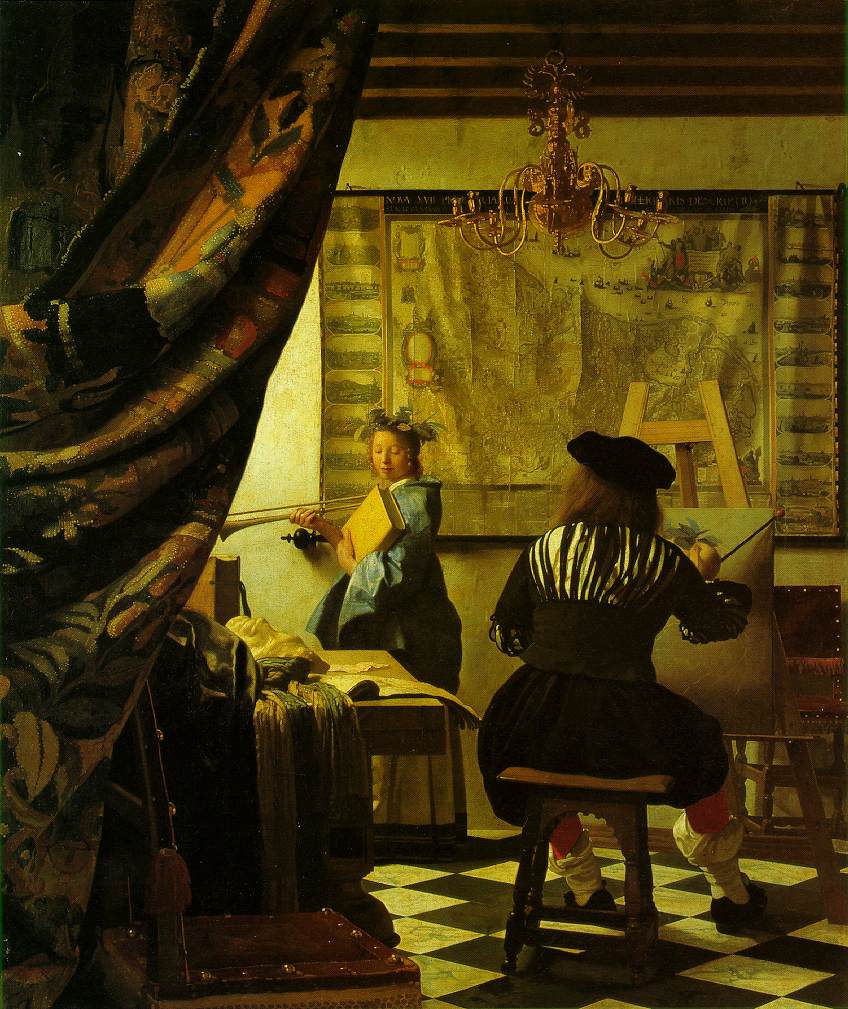Johannes Vermeer's extraordinary masterpiece The Art of Painting (c. 1666-1667) was on view at its exclusive venue in the United States,the National Gallery of Art, 24 November 1999 through 6 February 2000. The painting by the renowned seventeenth-century Dutch artist was not included in the "once-in-a-lifetime" exhibition Johannes Vermeer, held at the Gallery in 1995-1996, because it required conservation before traveling. Then, with the treatment completed, the Kunsthistoriches Museum, Vienna, offered this unique opportunity for Americans to view the painting outside of Austria.
This allegorical painting, unique for its large size (47 1/4" x 39 3/8") and intriguing to many for its mysterious qualities, was apparently very important to Vermeer, for he kept it in his possession throughout his lifetime. Even after his death, when his family was in dire financial straits, the painting was not sold. On 24 February 1676, Vermeer's widow, Catharina Bolnes, transferred ownership of it to her mother, Maria Thins, to keep it out of creditors' hands.
Very little is known about Vermeer (1623-1675), who lived and worked in Delft. He left no personal writings or drawings. Only thirty-five of his paintings are known to exist today; twenty-one were in the 1995-1996 exhibition in Washington. The Art of Painting was installed in the West Building in Gallery 51 with the four Vermeer paintings in the Gallery's permanent collection:

The Girl with the Red Hat (c. 1665),

A Lady Writing (c. 1665),

Woman Holding a Balance (c. 1664),
and
Young Girl with a Flute (probably 1665/1670, attributed to Vermeer).

The Art of Painting explores the complex relationship between art and history and the importance of the artist's role in society. In the work, a large curtain is drawn back revealing an artist painting a young model. Her attributes -- a laurel wreath for honor, a large book for history, and a trumpet for glory -- identify her as Clio, the Greek Muse of history. The artist, seated with his back to the viewer, has started to paint the wreath. The bond between art and history is also stressed in the large wall map of The Netherlands. Surmounting the elegantly crafted chandelier is an abstracted image of a double-headed eagle, the imperial symbol of the Hapsburg dynasty, which in the sixteenth century had held jurisdiction over the Netherlands.
The elaborately conceived interior was constructed according to the dictates of linear perspective. The vanishing point, which is evident in a small pinprick near Clio's hand, reinforces the direction of the artist's gaze as he prepares to record his model's image on the canvas.
The conservation effort reveals once again Vermeer's masterful observations of light. It also allows the viewer to experience the artist's extraordinary technique, which enabled him to convey a wide range of textures, from the irregular surface of the weathered map to the weave of the large illusionistic tapestry hanging in the foreground.
The painting was last seen in the United States as part of the 1949-1950 exhibition Art Treasures from the Vienna Collections, which was on view at the National Gallery of Art, Washington; The Metropolitan Museum of Art, New York; The Art Institute of Chicago; and the M.H. de Young Memorial Museum, San Francisco.
The curator of the focus exhibition The Art of Painting was Arthur K. Wheelock Jr., curator of northern baroque paintings, National Gallery of Art, who was also a curator of the 1995-1996 exhibition Johannes Vermeer with Frederik J. Duparc, director, Royal Cabinet of Paintings Mauritshuis, The Hague. That exhibition, which attracted 327,551 visitors in Washington and worldwide press coverage, was closed for 20 days owing to federal government shutdowns and blizzards. It opened on 12 November 1995 and closed on 11 February 1996.